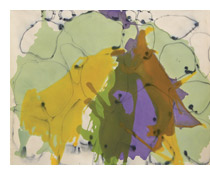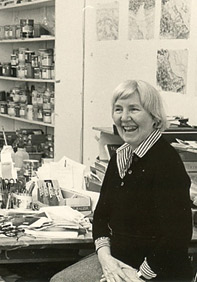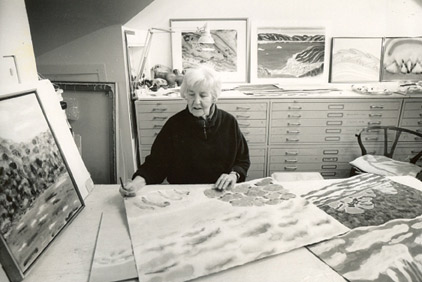K. M. Graham
Foreward
"I want my art to be an affirmation of life and to edify the spirit of the viewer."
K.M. Graham made this statement to me in 1968 when I first met her. Kate consistently accomplished this goal throughout her career, completing series after series of beautiful, evocative works full of her own deeply personal visual poetry. Her art related strongly to poetry of Emily Dickinson, whose writing inspired Kate to the depths of her soul.
The first works I saw of Kate's were from the Hallelujah Series. She painted them using a kitchen baster, applying fluid acrylic paint in long, irregular strands of varied colours from the centre outward, like exploding stars. As a younger artist in my twenties I was very excited about those works even though at the time I was painting landscapes that Kate considered "too brown!". She recommended that I paint the sky green in one of them just to see what would happen!
 By 1970 I was exhibiting large abstract paintings inspired by a trip to coral reefs alongside Kate's big stained works in a two artist show at Scarborough College. Kate herself did venture into pure abstraction but it was her description of nature in personal, modernist terminology that became the main feature of her work. By 1970 I was exhibiting large abstract paintings inspired by a trip to coral reefs alongside Kate's big stained works in a two artist show at Scarborough College. Kate herself did venture into pure abstraction but it was her description of nature in personal, modernist terminology that became the main feature of her work.
Kate travelled extensively throughout her life. In the early seventies she was inspired by the Aurora Borealis and other aspects of the Arctic landscape - her canvases from this period show broad prismatic colours radiating and shimmering. She spent part of each summer and fall at her cabin in Algonquin Park. There, she painted watercolours and pastel studies of water lilies from the frog pond, summer green or autumn coloured islands on the misty morning lake or against a starry night sky. While visiting the Channel Islands between England and France, she was transfixed by a large, yellow, rectangular field of daffodils next to a gorse filled moor. Kate showed me some small pastel sketches of this when she arrived home. Her excitement over the idea spawned the Field & Moor Series. These works perfectly exemplify Kate's remarkable ability to transpose natural subject matter into abstract language.
The majestic Laurentian Series from 1974 was executed by draping raw canvas over large plywood supports. They slanted downward into long metal troughs especially built to catch the runoff of paint and water. Acrylic colours were poured down the canvas in free flowing striped stains. She dramatically contrasted bright and deep hues which vibrated throughout these large paintings. The Laurentian Series raised qualities that were explored in some of the arctic paintings to new heights.
Kate's desire for asymmetry as evidenced in the Field & Moor Series carried into her paintings of the late 1970s. These works usually have a single colour in the shape of a vertical band at one end of the format. The rest of the canvas would be filled with clusters of analogous coloured shapes floating on a glowing tinted ground.
 In 1977, Kate's work was part of a major exhibition called "14 Canadians: A Critic's Choice" organized by the Hirshhorn Museum and Sculpture Garden, Washington D.C. The show included a strong group of painters headed by Jack Bush. Jack, who died just prior to the opening, was Kate's mentor and he was extremely proud of her achievements. In 1977, Kate's work was part of a major exhibition called "14 Canadians: A Critic's Choice" organized by the Hirshhorn Museum and Sculpture Garden, Washington D.C. The show included a strong group of painters headed by Jack Bush. Jack, who died just prior to the opening, was Kate's mentor and he was extremely proud of her achievements.
In 1980 we exhibited together again in a two-artist show at the Watson/Willour Gallery in Houston, Texas. Her paintings in this show were abstractions of plant
formations, derived from her pond paintings. Multicoloured leaf formations floated in mystical ovals of raw canvas. These radiant oval shapes were arranged in twos, threes and even up to seven or more, against large stained grounds of colour from deep charcoal and navy to whispered tints of dusty rose or azure blue. These works possess a refined sparseness and are beautifully quiet, meditative works.
Through the 1980s and 1990s Kate's work became less abstract but was still full of inventive, poetic interpretations of landscapes. Her subjects were taken from trips to Bermuda, Costa Rica, British Columbia, Newfoundland, Ontario and the Arctic. In particular, Newfoundland was a major source of inspiration in the 1990s. By 1998, she found painting large works physically different and so painted on smaller sized support. She most often worked her ideas - from pencil sketches to pastels and large watercolours - out on paper. After that she would usually paint a small group of paintings all of the same idea but after their proportion; she would then paint a few middle sized canvases and then some big ones. As such, these works are variations on a theme, much like Cezanne's Mt. St. Victoire paintings.
I recall her sticking small pieces of prismatic coloured tape on stained canvases like mosaic patterned landscapes. She would remove each piece of tape and paint the exact colour in its place parroting the shape of the piece of tape. She also had a collection of canvas pieces painted with each of the colours that she used. These canvas pieces were organized in plastic boxes or drawers according to hue. Kate would tape these small swatches of colour to certain areas of her paintings, which she preferred. Hans Hoffman had taken a similar approach, tacking painted matt board to his paintings before making decisions regarding the shape, size and colour of certain areas in the works. These canvas pieces were organized in plastic boxes or drawers according to hue. Kate would tape these small swatches of colour to certain areas of her paintings, which she preferred. Hans Hoffman had taken a similar approach, tacking painted matt board to his paintings before making decisions regarding the shape, size and colour of certain areas in the works.
Her works on paper always impress me and strike me as being absolutely exquisite - even in her old age they still flowed from her hand like little gems. Arthritis eventually prevented her from raising her arm up to paint effectively but she didn't complain about her problems. She simply took a practical view of life and adapted to the circumstances that confronted her.
Her last years before she was completely bedridden were spent putting her estate together; she devoted her time to writing her memoirs, as well as an article about her late husband, Dr. Wallace Graham, for the Arthritis Society. I remember helping Kate weed through her works in her studio. She was very disciplined and discriminating about her life and work and destroyed any painting that failed to meet the standard of quality she demanded of her art.
 Kate was frugal and picky over details; indeed, she often corrected my pronunciation, especially of artist's names - mainly Degas! That Kate was indebted to the artists she admired, like Milne, Bush, Avery, Matisse and Louis, is certainly true. Like all great artists do, Kate absorbed these influences into her own vision and visual languages, wherein producing some of Canada's most unique, striking and diverse works of art. Kate was frugal and picky over details; indeed, she often corrected my pronunciation, especially of artist's names - mainly Degas! That Kate was indebted to the artists she admired, like Milne, Bush, Avery, Matisse and Louis, is certainly true. Like all great artists do, Kate absorbed these influences into her own vision and visual languages, wherein producing some of Canada's most unique, striking and diverse works of art.
More than anyone, she carried the tradition of the landscape in Canadian Art, as embodied in the Group of Seven and Milne, into mainstream modernist painting of the mid to late twentieth century.
Kate started her painting when she was almost 50 years of age, after her husband died. I often wonder what she would have accomplished had she painted all her life. She was a very special friend to me, and I, along with her many other friends, who deeply miss her say, 'well done K.M. Graham, well done!' Kudos to you, always.
-Paul Fournier
2009
  
Click here to view the exhibit online
Click here to Download the catalogue in PDF format (4 MB)
|

